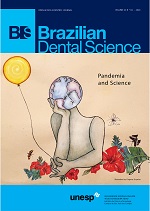Apical periodontitis in relation to radiographic quality of endodontic treatment in a selected adult Turkish population: A cross-sectional study
DOI:
https://doi.org/10.14295/bds.2020.v23i2.1874Resumo
Objective: The aim of this study was to examine the quality of root canal fillings and their relationship with apical periodontitis (AP) in a selected Turkish population. Material and Methods: The cases in this study was formed of patients attending routine dental treatment at the Faculty of Dentistry, University of Birun. 1024 patients were examined with panoramic radiographs and 1780 endodontically treated teeth with present periapical radiographs. Endodontic treatment quality was evaluated by obturation length, density, taper quality and iatrogenic errors. Presence of AP was analysed according to Ørstavik’s periapical index (PAI). The chi-square test was used for statistical analyses. Results: Statistically significant relationship was found between both the tooth type and location with obturation quality (p: 0.000; p < 0.05). Obturation quality of maxillary and mandibular molars are significantly less than the other tooth types in the same location. Apical periodontitis were noticed in 740 teeth (41.6%). Inadequate obturation quality was found to be significantly effective on the periapical status of tooth types both in maxilla and mandible (p < 0.05). Conclusion: The frequency of inadequate root canal obturations of endodontically treated teeth of the selected Turkish population was high, especially in molar teeth and women. Even though radiographic obturation quality is not the only success criteria in endodontic treatment, it is still one of the most important criteria regarding the positive correlation of “inadequate” obturations with AP.
KEYWORDS
Periapical periodontitis; Radiography; Root canal obturation; Root canal theraphy.
Downloads
Downloads
Publicado
Como Citar
Edição
Seção
Licença
TRANSFERÊNCIA DE DIREITOS AUTORAIS E DECLARAÇÃO DE RESPONSABILIDADE
Toda a propriedade de direitos autorais do artigo "____________________________________________________________________" é transferido do autor(es) para a CIÊNCIA ODONTOLÓGICA BRASILEIRA, no caso do trabalho ser publicado. O artigo não foi publicado em outro lugar e não foi submetido simultaneamente para publicação em outra revista.
Vimos por meio deste, atestar que trabalho é original e não apresenta dados manipulados, fraude ou plágio. Fizemos contribuição científica significativa para o estudo e estamos cientes dos dados apresentados e de acordo com a versão final do artigo. Assumimos total responsabilidade pelos aspectos éticos do estudo.
Este texto deve ser impresso e assinado por todos os autores. A versão digitalizada deverá ser apresentada como arquivo suplementar durante o processo de submissão.




























